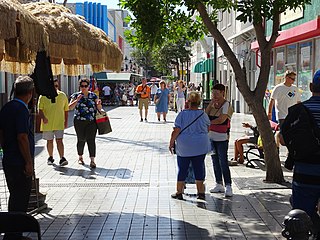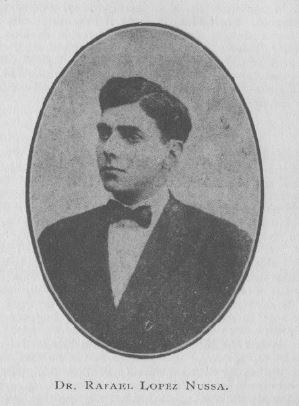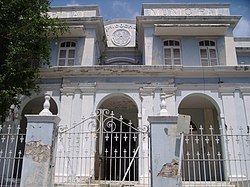
Manuel Zeno Gandía was a Puerto Rican physician, poet, novelist, journalist and politician. He is best known as the author of La Charca, a novel considered by many to be the first Puerto Rican novel.

Teatro La Perla is a historic theater in the city of Ponce, Puerto Rico. Inaugurated in 1864, it is the second oldest theater of its kind in Puerto Rico, but "the largest and most historic in the Spanish-speaking Caribbean." The theater was named La Perla in honor of the Virgin of Montserrat, known as "The Pearl of the Mediterranean." It is located in barrio Tercero, in the Ponce Historic Zone.

Paseo Atocha is a pedestrian shopping mall in the Ponce Historic Zone, a historic district in Ponce, Puerto Rico. For over a century the narrow Calle Atocha was bustling retail center opened to vehicular traffic, yet flooded with shoppers. Congestion and pedestrian safety led the municipal government to close the two blocks of Calle Atocha from Calle Isabel to Calle Vives to motor vehicles in 1991. Several years later, the closure was expanded to include the block from Calle Vives to Calle Victoria. This last segment coincides with the western perimeter of the historic Plaza de Mercado Isabel II city market. Not the bustling commercial spot it once was, today it is still actively frequented by shoppers, though in much reduced numbers. It is visited annually by thousands of locals and tourists alike and is considered one of the city’s main places of interest.
Luis de Quixano y Font was Mayor of Ponce, Puerto Rico, from 11 July 1863 to 23 June 1865.
Miguel Rosich y Más was Mayor of Ponce, Puerto Rico, from 8 May 1889 until 31 March 1890, and again in 1897, starting on 1 April 1897.

Plaza Degetau, formally Plaza Federico Degetau, is the larger of two plazas at Plaza Las Delicias, the main city square in the city of Ponce, Puerto Rico. The other plaza is named Plaza Muñoz Rivera and is located north of Plaza Degetau. The square is notable for its fountains and for the various monuments it contains. The historic Parque de Bombas and Ponce Cathedral buildings are located bordering the north side of this plaza. The square is the center of the Ponce Historic Zone, and it is flanked by the historic Ponce City Hall to the south, the cathedral and historic firehouse to the north, the NRHP-listed Banco Crédito y Ahorro Ponceño and Banco de Ponce buildings to the east, and the Armstrong-Poventud Residence to the west. The square dates back to the early Spanish settlement in Ponce of 1670. It is the main tourist attraction of the city, receiving about a quarter of a million visitors per year.

Emilio J. Pasarell (1891–1974) was a Puerto Rican short story writer, novelist, essayist and historian.
Luis Gautier y Quesada was Mayor of Ponce, Puerto Rico, from 8 December 1897 to 20 June 1898. He was the first of two mayors to lead the municipality of Ponce under the Spanish Crown's "Decreto Autonómico para Puerto Rico", whereby Puerto Rico was granted autonomy by Spain.
Juan José Cartagena was Mayor of Ponce, Puerto Rico, from April 1876 to 4 July 1879, and again from February 1881 to October 1881.

Valentín Tricoche was a Puerto Rican land owner and philanthropist from Ponce, Puerto Rico. He is best remembered for his generous donation that made possible the building of Hospital Tricoche.

Rafael López Nussa was a Puerto Rican physician and public servant. In 1916 López Nussa performed the first heart surgery operation in Puerto Rico.
Juan José Potous y de la Lastra was Mayor of Ponce, Puerto Rico, from 12 July 1895 to 10 May 1896.
Eduardo Armstrong Toro was Mayor of Ponce, Puerto Rico, from 1894 to 3 May 1895. He was the brother of Thomas Armstrong Toro, for whom a high school is named in Ponce, Puerto Rico.
Alejandro Ordóñez was Mayor of Ponce, Puerto Rico, from 3 January 1816 to 31 December 1818. He was a teniente justicia mayor.
Socorro Girón was a Puerto Rican historian, writer, and scholar. She is best known for her legendary book "Ponce, el teatro La Perla y La Campana de la Almudaina: Historia de Ponce desde sus comienzos hasta la Segunda Decada del Siglo XX."
Tomás de Renovales was a Spanish military commander for the southern region of Puerto Rico in the first half of the 19th century and de facto Mayor of the city of Ponce in 1831. He held the rank of colonel.
Guillermo Neumann was Mayor of Ponce, Puerto Rico, from 23 April 1851 to 30 September 1851.
Francisco Romero was an interim Mayor of Ponce, Puerto Rico, in 1847 and again in 1866.
Peñón de Ponce is a boulder in the municipality of Ponce, Puerto Rico, located in the western coastal section of the municipality, in Sector Punta Cucharas, Barrio Canas, immediately north of Puerto Rico Highway 2 (PR-2), kilometer 220.1. The Peñón de Ponce promontory separates the Port of Tallaboa from the plains that give access to the municipality of Ponce.









